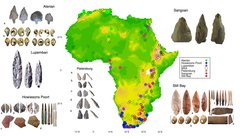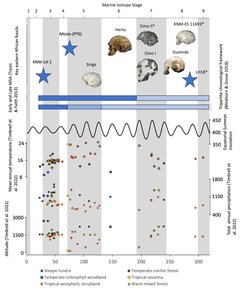Between Climate and Culture: Exploring Middle Stone Age Archaeological Diversity in Eastern Africa
A recent systematic review by new Human Palaeosystems Group member Dr. Lucy Timbrell highlights links between climate change, population dynamics and archaeological diversity in eastern Africa during the Middle Stone Age, the period of prehistory linked to the emergence of our species.
Eastern Africa has historically held a key position in debates surrounding the emergence of Homo sapiens across Africa. This is because decades of research in the region have revealed a rich fossil record in association with highly variable material culture. Starting from around 300,000 years ago across most of Africa, large cutting tools like hand axes were abandoned in favour of prepared core technology and the hafting of pointed pieces to form projectile weapons. This marked a major technological shift, referred to by archaeologists as the Middle Stone Age (MSA).
In addition to a shift in stone tool technology, the MSA saw the proliferation of other behaviours typically associated with ‘complex culture’, such as pigment use and intentionally perforated shells, probably used for personal ornamentation and symbolic behaviour, and the inhabitation of more diverse environments with varied resources.
The MSA also marks the first widespread evidence of regionally distinctive material culture styles in Africa, although their appearance is patchy. The sporadic appearance of these ‘specific’ regional innovations occurs alongside more ‘generic’ elements that seem to represent the baseline of technology present across large areas throughout much of the MSA.

This pattern of regionalisation was historically linked with the punctuated appearance of ‘modern’ cognition during the MSA. In this view, the appearance of ‘specific’ behaviours in certain regions was thought to represent distinct periods of cultural efflorescence in cognitively diverse populations. However, the new review shows that the pattern of innovation revealed by the archaeological record across Africa may reflect the interaction between demographic and ecological variables, as well as differences in research history between regions.
“Multiple archaeological studies of the MSA across Africa note a link between the distribution and density of sites, archaeological diversity, and environmental conditions, with ecology and demography often proposed to be key drivers of cultural evolution,” says Timbrell. “Interestingly, the archaeological record in equatorial Africa, like eastern Africa, appears quite different from the record in northern and southern Africa, with these more extreme latitudal areas appearing to have a more structured appearance and, perhaps more interestingly, disappearance of cultural innovations.”
Timbrell’s study focussed on exploring the archaeological and palaeoclimatic evidence from eastern Africa. In her view, the climatic record could indicate much of Eastern Africa as a refugial zone within Pleistocene Africa, providing consistently suitable conditions for survival that were characterised by high and changing biodiversity. She argues that this may have allowed population growth, inter-regional connectivity and material culture diversification reflected in the archaeological record. The study concludes by suggesting that this interplay between population dynamics, innovation and ecological adaptation likely played a part in the expansion of the human niche, leading to the eventual colonisation of all environments across the world.

The new article forms part of a special issue of Azania, guest edited by Human Palaeosystems Group leader Prof. Eleanor Scerri and Dr.Manuel Will of the University of Tubingen. The special issue is based on a symposium at the Sixteenth Congress of the PanAfrican Archaeological Association of Prehistory and Related Studies in Zanzibar (Tanzania) which brought together researchers working in different African regions to scrutinise apparently generic MSA lithic assemblages across time and space, evaluating their commonality and relevance on different chronological and geographical scales.

